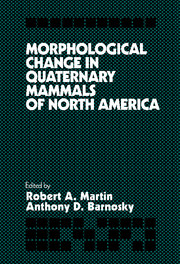Book contents
- Frontmatter
- Contents
- List of Contributors
- Acknowledgments
- 1 Quaternary mammals and evolutionary theory: introductory remarks and historical perspective
- 2 A method for recognizing morphological stasis
- 3 Mosaic evolution at the population level in Microtus pennsylvanicus
- 4 Variogram analysis of paleontological data
- 5 Morphological change in Quaternary mammals: a role for species interactions?
- 6 Rates of evolution in Plio-Pleistocene mammals: six case studies
- 7 Patterns of dental variation and evolution in prairie dogs, genus Cynomys
- 8 Quantitative and qualitative evolution in the giant armadillo Holmesina (Edentata: Pampatheriidae) in Florida
- 9 Evolution of mammoths and moose: the Holarctic perspective
- 10 Evolution of hypsodonty and enamel structure in Plio-Pleistocene rodents
- 11 Patterns of variation and speciation in Quaternary rodents
- 12 Decrease in body size of white-tailed deer (Odocoileus virginianus) during the late Holocene in South Carolina and Georgia
- 13 Short–term fluctuations in small mammals of the late Pleistocene from eastern Washington
- 14 Size change in North American Quaternary jaguars
- 15 Ontogenetic change of Ondatra zibethicus (Arvicolidae, Rodentia) cheek teeth analyzed by digital image processing
- 16 Morphological change in woodrat (Rodentia: Cricetidae) molars
- Index
7 - Patterns of dental variation and evolution in prairie dogs, genus Cynomys
Published online by Cambridge University Press: 15 December 2009
- Frontmatter
- Contents
- List of Contributors
- Acknowledgments
- 1 Quaternary mammals and evolutionary theory: introductory remarks and historical perspective
- 2 A method for recognizing morphological stasis
- 3 Mosaic evolution at the population level in Microtus pennsylvanicus
- 4 Variogram analysis of paleontological data
- 5 Morphological change in Quaternary mammals: a role for species interactions?
- 6 Rates of evolution in Plio-Pleistocene mammals: six case studies
- 7 Patterns of dental variation and evolution in prairie dogs, genus Cynomys
- 8 Quantitative and qualitative evolution in the giant armadillo Holmesina (Edentata: Pampatheriidae) in Florida
- 9 Evolution of mammoths and moose: the Holarctic perspective
- 10 Evolution of hypsodonty and enamel structure in Plio-Pleistocene rodents
- 11 Patterns of variation and speciation in Quaternary rodents
- 12 Decrease in body size of white-tailed deer (Odocoileus virginianus) during the late Holocene in South Carolina and Georgia
- 13 Short–term fluctuations in small mammals of the late Pleistocene from eastern Washington
- 14 Size change in North American Quaternary jaguars
- 15 Ontogenetic change of Ondatra zibethicus (Arvicolidae, Rodentia) cheek teeth analyzed by digital image processing
- 16 Morphological change in woodrat (Rodentia: Cricetidae) molars
- Index
Summary
Prairie dogs are large, distinctive ground squirrels of the genus Cynomys that occur today on the Great Plains and on high plateaus and basins of the Rocky Mountains from southern Saskatchewan to northern Mexico. Two subgenera (Cynomys and Leucocrossuromys) and five extant species currently are recognized (Pizzimenti, 1975). The members of the two subgenera are referred to as black-tails and white-tails, respectively, designations that will be used in this chapter. The genus extends from the late Pliocene (late Blancan) to the Recent, but the record is best known for the late Pleistocene (late Irvingtonian and Rancholabrean) and Recent. The fossil record of the genus was recently reviewed (Goodwin, 1990).
The purpose of this chapter is to document patterns of morphological variation in several characters of fossil and Recent prairie dogs and to consider the tempo, mode, and causes of evolution as inferred from these patterns. The patterns that are treated include temporal variations in measures of dental size and “shape,” in sample variability of measures of size, and in frequency of a nonmetric character, as well as latest Pleistocene (late Rancholabrean) geographic variations in measures of size and shape.
Materials and methods
Variables
This study was restricted to lower jaws and dentitions because relatively large sample sizes are available in the fossil record for these elements. Ten measurements originally were obtained: length of the lower alveolar row (MDALV); individual lengths of P4-M3; trigonid and talonid widths of P4; and trigonid widths of M1-M3.
- Type
- Chapter
- Information
- Morphological Change in Quaternary Mammals of North America , pp. 107 - 133Publisher: Cambridge University PressPrint publication year: 1993
- 1
- Cited by

